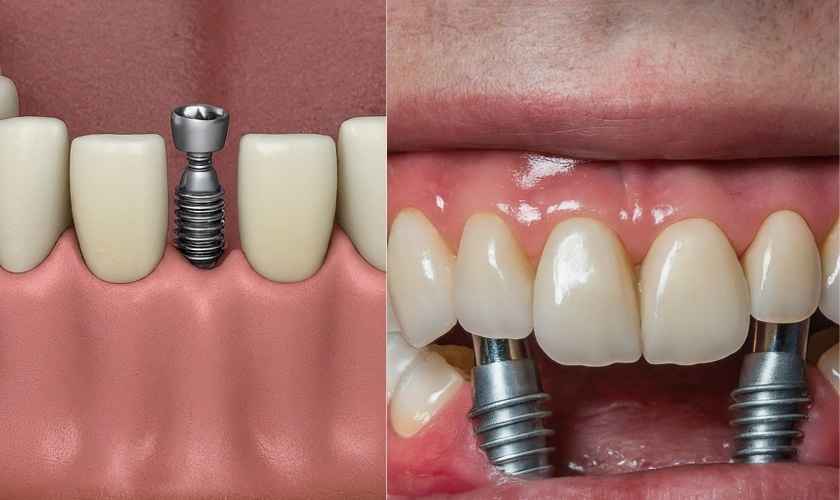Dental Sense Things To Know Before You Buy
Table of ContentsThe Definitive Guide for Dental SenseFascination About Dental SenseThe 9-Minute Rule for Dental SenseAll about Dental Sense
are clinical devices operatively dental implanted into the jaw to bring back an individual's ability to chew or their look. They provide assistance for artificial (phony) teeth, such as crowns, bridges, or dentures. When a tooth is lost due to injury or condition, a person can experience difficulties such as fast bone loss, malfunctioning speech, or adjustments to chewing patterns that result in discomfort.Oral dental implant systems contain an oral implant body and oral implant abutment and may likewise include an abutment addiction screw. Cosmetic dentistry services. The oral implant body is operatively put in the jawbone in area of the tooth's origin. The oral implant joint is usually affixed to the dental implant body by the abutment addiction screw and extends via gum tissues into the mouth to sustain the attached synthetic teeth
(https://forums.hostsearch.com/member.php?274218-dentalsense1)Structure of The Dental Implant System choosing oral implants, speak with your oral company about the potential advantages and dangers, and whether you are a prospect for the treatment. Things to think about: Your total wellness is a vital element in establishing whether you are a great candidate for oral implants, the length of time it will take to heal, and the length of time the implant may stay in place.
Smoking cigarettes might affect the recovery process and lower the long-term success of the dental implant. The recovery procedure for the implant body might take a number of months or longer, during which time you generally have a momentary joint in place of the tooth. the oral implant treatment: Meticulously comply with the dental health directions provided to you by your dental copyright.
What Does Dental Sense Mean?
Implant failing can result in the demand for an additional surgery to take care of or change the dental implant system. Restores the capacity to chew Brings back cosmetic appearance Helps keep the jawbone from reducing because of bone loss Preserves the health and wellness of the bordering bone and gums Helps maintain nearby (close-by) teeth steady Improves top quality of life Damages to bordering natural teeth during implant positioning Injury to the surrounding cells throughout surgical procedure, such as sinus perforation Injury during surgery (as an example, crack of surrounding jawbone) Poor feature, such as feeling like the teeth do not bite together generally A sensation that the tooth hangs or twisting in position resulting from an abutment screw loosening Implant body failure (looseness of the dental implant body) because of systemic infection, which might be most likely in patients with unrestrained diabetes mellitus due to regional infection in bone and gum tissues supporting the dental implant body due to delayed healing, which may be most likely in patients that smoke Difficulty cleansing the gums around the implant, causing bad oral health Neglected periodontal condition Post-surgical pins and needles as a result of nerve impingement or damages Always inform healthcare carriers and imaging specialists that you have oral implants before any kind of magnetic vibration imaging (MRI) or x-ray treatments.
FDA is not knowledgeable about any type of unfavorable events reported for MRI or x-ray procedures with dental implants. Dental implants systems are usually made of products that follow international consensus standards of the International Organization for Standardization (ISO) or ASTM International. These standards have information of what makes a secure product.

An oral implant is a framework that replaces a missing tooth. With screw-like tools, the specialist inserts a dental implant right into the jawbone, and it acts as an anchor for a man-made tooth, called a crown.
Rumored Buzz on Dental Sense
Some individuals are not qualified for dental implant surgical procedure. It is for dental doctors to run on people with: acute illnessuncontrollable metabolic diseasebone or soft cells illness or infectionIf these problems are settled, an individual can have the surgical procedure. In, oral doctors avoid operating individuals with: If people with any one of the above undertake dental implant surgical treatment, there is a higher risk of the implant failing.

Oral implant surgical procedure is a tailored process. Provide you time to recover. Affix the article and final crown, bridge or denture.
Next, your doctor will thoroughly position the dental implant into your jaw. Lastly, your cosmetic surgeon will certainly rearrange your gums and close the laceration with stitches. If your dental implant is near the front of your mouth, your dental practitioner will certainly make a temporary tooth for you to use till you recover. By doing this, you will not have a void in your smile while you recover.
The Best Strategy To Use For Dental Sense
Your copyright can tell you what to anticipate in your circumstance. During the healing stage, your jawbone must fuse to the oral implant. This process, called osseointegration, is important for security and long-lasting success. This process can take anywhere from three to 9 months. In many cases, it might take much longer.
When your implant heals, your dental practitioner can attach the joint (tiny connector article) and your last reconstruction (crown, bridge or denture). This normally takes regarding one hour to finish and may need a 2nd minor surgery. You shouldn't really feel any kind of discomfort during your dental implant procedure since your copyright will certainly utilize medication to numb your periodontals.